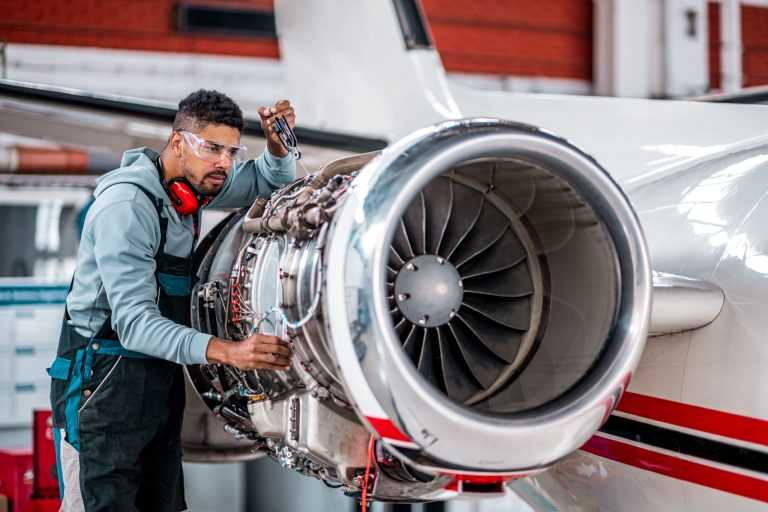
Owning an aircraft is a significant investment, and proper maintenance is crucial to ensure its longevity, safety, and performance. Whether you own a private jet, a turboprop, or a small single-engine plane, regular maintenance is non-negotiable. In this blog, we’ll explore essential aircraft maintenance tipsto help you keep your aircraft in top condition and avoid costly repairs down the line.
1. Follow the Manufacturer’s Maintenance Schedule
- Every aircraft comes with a detailed maintenance manual provided by the manufacturer. This manual outlines specific maintenance tasks and intervals based on flight hours, calendar time, or cycles (takeoffs and landings).
- Tip: Stick to the recommended schedule for inspections, oil changes, and part replacements. Ignoring these guidelines can void warranties and compromise safety.
2. Conduct Regular Inspections
- Pre-Flight Inspections: Before every flight, perform a thorough pre-flight check. Look for signs of wear, leaks, or damage to the exterior, engine, and landing gear.
- Post-Flight Inspections: After landing, inspect the aircraft for any issues that may have arisen during the flight.
- Annual Inspections: Schedule a comprehensive annual inspection with a certified aviation maintenance technician (AMT). This is a regulatory requirement for most aircraft.
3. Keep the Exterior Clean
- Dirt, grime, and debris can damage the aircraft’s exterior and affect its aerodynamics. Regular cleaning helps prevent corrosion and maintains the aircraft’s appearance.
- Tip: Use cleaning products specifically designed for aircraft to avoid damaging the paint or materials.
4. Monitor Engine Health
- The engine is the heart of your aircraft, and its maintenance should be a top priority.
- Oil Changes: Change the engine oil and filter at recommended intervals to ensure smooth operation.
- Compression Checks: Regularly check cylinder compression to identify potential engine issues early.
- Tip: Keep an eye on engine performance metrics like oil pressure, temperature, and fuel consumption.
5. Check and Maintain the Landing Gear
- The landing gear undergoes significant stress during takeoffs and landings. Regular maintenance is essential to prevent failures.
- Inspect Tires: Check tire pressure and tread wear before every flight. Replace tires as needed.
- Lubricate Moving Parts: Ensure all moving parts are properly lubricated to reduce wear and tear.
- Tip: Look for signs of corrosion or cracks in the landing gear structure.
6. Pay Attention to the Electrical System
- Modern aircraft rely heavily on electrical systems for navigation, communication, and instrumentation.
- Battery Maintenance: Check the battery’s charge level and clean the terminals regularly. Replace old or weak batteries promptly.
- Wiring Inspections: Look for frayed wires, loose connections, or signs of overheating.
- Tip: Keep spare fuses and bulbs on hand for quick replacements.
7. Prevent Corrosion
- Corrosion is one of the biggest threats to an aircraft’s structural integrity, especially in humid or coastal environments.
- Regular Cleaning: Wash the aircraft regularly to remove salt, dirt, and moisture.
- Protective Coatings: Apply anti-corrosion treatments to vulnerable areas.
- Tip: Store the aircraft in a hangar to protect it from the elements.
8. Maintain the Interior
- A well-maintained interior ensures comfort and safety for passengers and crew.
- Clean Upholstery: Regularly clean seats, carpets, and panels to prevent wear and tear.
- Check Safety Equipment: Ensure that emergency equipment like life vests, fire extinguishers, and first aid kits are in good condition and up to date.
- Tip: Replace worn-out or damaged interior components promptly.
9. Keep Accurate Maintenance Records
- Detailed maintenance records are not only a regulatory requirement but also essential for resale value and troubleshooting.
- Log Everything: Record all maintenance activities, inspections, and repairs.
- Digital Tools: Use maintenance management software to track schedules and generate reports.
- Tip: Keep both physical and digital copies of your records for easy access.
10. Work with Certified Professionals
- While some maintenance tasks can be performed by owners, many require the expertise of certified aviation maintenance technicians (AMTs).
- Choose Reputable Providers: Partner with experienced and certified maintenance providers.
- Stay Involved: Even when outsourcing maintenance, stay informed about the work being done.
- Tip: Build a long-term relationship with a trusted AMT or maintenance facility.
11. Plan for Seasonal Maintenance
- Different seasons bring unique challenges for aircraft maintenance.
- Winter: Protect the aircraft from freezing temperatures by using engine heaters and antifreeze.
- Summer: Monitor cooling systems and ensure proper ventilation to prevent overheating.
- Tip: Adjust your maintenance routine based on seasonal needs.
12. Invest in Training
- As an aircraft owner, understanding the basics of maintenance can help you identify potential issues early and communicate effectively with technicians.
- Take Courses: Consider enrolling in aviation maintenance courses or workshops.
- Stay Updated: Keep up with industry trends and best practices.
- Tip: Join aviation forums or communities to learn from other owners.
Final Thoughts
Proper aircraft maintenance is not just about compliance—it’s about ensuring the safety, performance, and value of your investment. By following these essential tips and working with certified professionals, you can enjoy worry-free flights and extend the lifespan of your aircraft.
Remember, an ounce of prevention is worth a pound of cure. Happy flying!

Leave a Reply